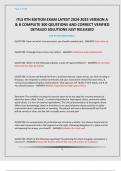Page 1 of 45
ITLS 9TH EDITION EXAM LATEST 2024-2025 VERSION A
& B COMPLETE 300 QEUSTIONS AND CORRECT VERIFIED
DETAILED SOLUTIONS JUST RELEASED
ITLS 9TH EDITION EXAM 1
QUESTION: Upon arrival at a trauma scene, you should complete a(n) - ANSWER-Scene Size-up
QUESTION: Prolonged scene times may reflect: - ANSWER-Ineffective team collaboration
QUESTION: Which of the following indicates a state of hyperventilation? - ANSWER-An end tidal
CO2 level less than 30 mmHG
QUESTION: A 23 year old female fell from a 2nd floor balcony. Upon arrival, you find her lying in
the grass. She responds to verbal commands and your assessment reveals flat neck veins, &
normal chest/abdomen/pelvic examinations. Vital signs are: BP 74/40, P 54 & Weak, and R 16.
You should suspect: - ANSWER-Relative hypovolemic (high-space) shock
Rationale: The condition causing the vascular space to be too large for a normal amount of
blood has been called "shock", or relative hypovolemia. Neurogenic shock, commonly called
spinal shock, is a form of relative hypovolemia. The clinical presentation of neurogenic shock
differs from hemorrhagic shock in that there is no catecholamine release and this no pallor
(vasoconstriction), tachycardia, or sweating. The patient will have a decreased BP but the HR
will be normal or slow, and the skin is usually warm, dry and pink
QUESTION: An unresponsive 34 y/o female was struck by a vehicle. You observe Asymmetrical
chest wall movement with a flail segment on the right. Following delegation of c-spine control
and opening the airway, you should? - ANSWER-Stabilize the chest wall
QUESTION: Which of the following regarding PT positioning for external jugular cannulation is
Incorrect? - ANSWER-Elevate the head to distend the vein and prevent air embolism.
1
,Page 2 of 45
Rationale: The PT must be in the supine position, preferably head down, to distend the vein and
prevent air embolism.
QUESTION: Which of the following set of vital signs is most compatible with a diagnosis of
isolated traumatic brain injury with increasing ICP? - ANSWER-BP 170/100, P 50
Rationale: When the ICP increases, the systemic BP increases to try to preserve blood flow to
the brain. The body senses the rise in systemic BP, and this triggers a drop in the pulse rate as
the body tries to lower the systemic BP
QUESTION: Which of the following statements is incorrect regarding spinal motion restriction? -
ANSWER-Neck traction should be applied to extend the neck upward during cervical collar
application
QUESTION: A 15 y/o male was stabbed and has an abdominal evisceration. The PT is A/O, BP
112/68, P 94, R18. You should? - ANSWER-Prepare PT for transport & establish vascular access
during transport.
QUESTION: A 33yo female's leg was trapped in a piece of industrial equipment and has been
extricated. She is now complaining of secure lower leg pain. PT is A/O with no signs of external
hemorrhage. Vital signs are:
BP 132/78, P 96, R 20. Which of the following is indicated? - ANSWER-Administer pain
medication
QUESTION: Establishing vascular access on scene is indicated: - ANSWER-To administer
medication
2
,Page 3 of 45
QUESTION: Which of the following changes is most useful to monitor in the child with head
injury? - ANSWER-Level of consciousness
Rationale: changing of LOC is the best indicator of traumatic brain injury
QUESTION: In the geriatric PT, which of the following findings is most likely caused by an acute
injury? - ANSWER-Hypotension
QUESTION: A 31yo female was the restrained driver of a vehicle that hit a utility pole at
moderate speed. The drivers side airbag deployed. She is A/O & anxious. She reports that she is
8mo pregnant and complain of abdominal, chest and lower extremity pain. Her vital signs are
BP 100/60, P 90, R 20. Your impression and interventions are: - ANSWER-Early signs of shock.
Treat with O2, fluid administration, at "keep open" rate.
Rationale: Do not mistake normal vital signs in pregnant PTs. The pregnant PT has a normal
resting pulse that is 10-15 beats faster than usual, and the BP is 10-15mmHG lower than usual.
However, it is also important to realize that a BP loss of 30% can occur in these PTs before there
is a significant change in BP
QUESTION: A disoriented 23yo male is injured in a motorcycle collision. The PT appears to be
intoxicated and does not want medical attention despite a large laceration on his scalp, which is
actively bleeding. You should: - ANSWER-Treat him as a head injury PT
QUESTION: What is the most common cause of cardiopulmonary arrest in the trauma PT? -
ANSWER-Hypoxemia
Rationale: Hypoxemia is the most common cause of traumatic cardiopulmonary arrest. Acute
airway obstruction or ineffective breathing will be clinically manifested in hypoxemia
3
, Page 4 of 45
QUESTION: You may have been exposed to a contaminant (air or fluid borne). You should: -
ANSWER-Seek treatment within hours of the exposure
QUESTION: A 24 yo male is involved in a head on collision. If you suspect: - ANSWER-A chest
injury, obtain an EKG
Rationale: Consider a bruised chest wall as a myocardial contusion that requires monitoring of
cardiac rhythm and, if available, a 12-lead ECG
QUESTION: A brief neurologic exam of an AMS pt includes: - ANSWER-GCS, glucose check, pupil
exam
QUESTION: Which of the following findings would indicate the airway needs to be suctioned? -
ANSWER-Gurgling sounds with respiration
QUESTION: Overinflation of an LMA mask can cause all of the following except: - ANSWER-
Vomiting
Rationale: Overinflation may cause malposition, loss of seal or trauma
QUESTION: A 54 yo male is involved in a MVC. The steering wheel is bent. During your initial
assessment, you note his skin is pale, radial pulses are present and breath sounds are clear.
Which one of the following is most consistent with these findings - ANSWER-Cardiac contusion
Rationale: Bruising of the heart is basically the same injury as an acute MI
QUESTION: Which of the following is NOT a potential complication of performing chest
decompression? - ANSWER-Difficulty monitoring the site.
4




